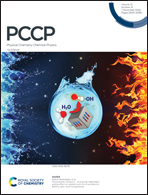UV-photoelectron spectroscopy of stable radicals: the electronic structure of planar Blatter radicals as materials for organic electronics†
Abstract
The electronic structure of Blatter radicals and a series of C(10)-substituted derivatives of 2-phenyl-3H-[1,2,4]triazino[5,6,1-kl]phenoxazin-3-yl (planar Blatter radicals) containing H, F, Cl, Br, CN, CF3 and OMe substituents was investigated by gas phase UV-photoelectron spectroscopy. The energy of the SOMO of the radicals, determined to be about 6.5 eV, was correlated with their electrochemical oxidation potentials, E0/+11/2, relative to the Fc/Fc+ couple in CH2Cl2 giving the correction of 6.60(1) eV. The optical band gap Eoptg ∼ 1.7 eV of the radicals yielded the electronic transport gap, Eelg, of about 2.1 eV, which is similar to the electronic parameters of pentacene. The radicals were analyzed by EPR spectroscopy and single crystal XRD methods, and all experimental data were compared to DFT computational results obtained at the CAM-B3LYP/6-311G(d,p) level of theory.



 Please wait while we load your content...
Please wait while we load your content...